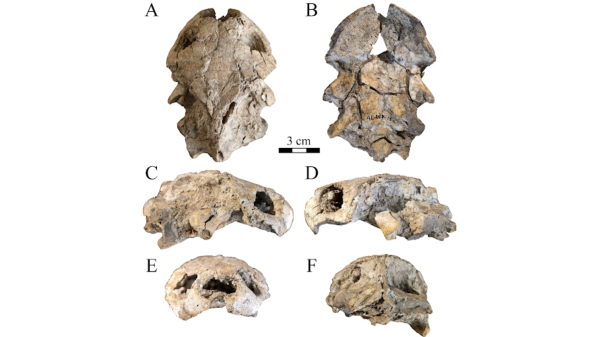The White House on Tuesday released a comprehensive scientific analysis of the impacts of global climate change in the United States in its Fifth National Climate Assessment (NCA5).
The report, contributed to by 12 faculty members from Arizona State University, is considered to be a highly influential scientific assessment, as well as a scientific consensus regarding climate change impacts, mitigation and adaptation strategies across the country.
The nationwide report, which looks at current and future climate impacts, shows that people across the U.S. are facing increasing climate-related risks that include warmer temperatures, heatwaves, severe drought and flooding, as well as wildfires and hurricanes that are more frequent and severe.
Additionally, underserved and overburdened communities are facing increased impacts of climate change because of persistent social and economic inequities.
The report also demonstrates that the U.S. is making progress adapting to climate change impacts — an encouraging sign amidst increasing global greenhouse gas emissions from human activities.
"As shown in the Fifth National Climate Assessment, the Southwest — including Arizona — is taking action on climate change,” said Dave White, director of the Global Institute of Sustainability and Innovation at ASU, as well as lead author of the NCA5 chapter on the Southwest region.
“Governments, nongovernmental organizations, universities and private enterprises are responding to climate impacts with innovative solutions, increasing adaptation and resilience. Climate action offers unparalleled opportunities to improve well-being, benefit the economy and create a more just future for our state and region."
While greenhouse gas emissions have fallen in the U.S. since peaking in 2007 and efforts to reduce emissions have increased since the last National Climate Assessment published in 2018, severe climate change impacts are still expected to rise without urgent and immediate action to further reduce emissions and accelerate both mitigation and adaptation efforts nationwide.
“The Fifth National Climate Assessment demonstrates that our choices, individually and collectively, matter immensely as they relate to climate change,” said Peter Schlosser, director of the Julie Ann Wrigley Global Futures Laboratory at ASU. “We will continue to experience the detrimental and life-altering effects of wildfires, drought, water scarcity, food insecurity, extreme heat and social inequities unless we act with urgency to combat climate change. What we choose to do today will determine our future.”
Climate change impacts in the Southwest
The report highlights five key areas of concern for the Southwest region, which comprises Arizona, California, Utah, Nevada, Colorado and New Mexico. The Southwest is home to more than 60 million people.
"The assessment demonstrates that the impacts of climate change in the Southwest have become increasingly apparent and widespread in recent years,” White said. “Climate change is impacting the region's water resources, coast and ocean, agriculture, human health and wildfire events. The report also documents the best available science, which informs actions communities are taking to adapt."
Water security continues to be a big concern in the region, as drought and increasing aridity threaten remaining water supplies. Climate change has reduced both groundwater and surface-water supplies both for people and nature.
New science in the report shows that higher temperatures are driving much of the change. Meanwhile, the Southwest is experiencing a rise in extreme weather events, such as atmospheric rivers and flooding.
Along the coast, marine ecosystems are experiencing the impacts of large-scale marine heatwaves and harmful algal blooms. This not only has a profound and negative effect on marine life, it also diminishes the economies and fisheries that depend on a healthy ocean. Sea level rise, caused by melting glaciers, impacts flooding, saltwater intrusion and critical infrastructure, especially in overburdened and underserved communities.
The Southwest is an important region for producing a variety of crops such as lettuce, alfalfa, chiles, pinto beans, grapes, peanuts and wheat, as well as alfalfa and cotton. However, water scarcity and drought are making it more difficult to raise food and fiber in the region. And, extreme heat is reducing crop quality and yield, and stressing both humans and animals. Adaptation strategies include the integration of Indigenous knowledge with technological innovation to help protect food security and sovereignty.
Human health and demographics are affected by environmental changes, as well. Residents in the Southwest are facing an influx of migration, the physical effects of extreme wildfires, and the impacts of extreme heat on older adults, outdoor workers and people with low income. In Arizona, the Department of Health Services created new policies for heat safety and adaptation in schools.
Finally, the Southwest is experiencing unprecedented wildfire events that are driven in part by climate change. This affects everything from housing to food production to hydropower and electricity generation.
“We have improved our understanding of the interconnectivity of these issues, which helps us design strategies that address risks and improve resilience across multiple areas,” White said. “Climate impacts are accelerating rapidly. Americans are experiencing increased risks from extreme events, which causes disproportionate risks to those in underserved communities.
"But we have an opportunity here. Climate action and adaptation gives us an opportunity to advance transformative climate actions that can strengthen resilience and advance equity.”
A bright spot: Mitigation and adaptation making progress nationwide
The report illustrates that the U.S. is taking action on climate change across the country. In every region, cities and states have adaptation and mitigation efforts underway.
Wind and solar energy costs have dropped 90% over the last decade, and up to 80% of new generation capacity just three years ago came from renewable sources. And low-carbon jobs are increasing, projected to offset the losses in jobs in the fossil fuel industry.
In the Southwest, the water crisis and hotter temperatures are driving urgent mitigation efforts. For example, the federal government issued mandatory cuts to Colorado River water usage in 2021.
In Arizona, the state launched the Arizona Water Innovation Initiative, a statewide project led by the ASU Global Futures Laboratory to work with industrial, municipal, agricultural, tribal and international partners to rapidly accelerate and deploy new approaches and technology for water conservation, augmentation, desalination, efficiency, infrastructure and reuse.
The use of solar power is increasing across the region, and the city of Phoenix opened the country’s first Office of Heat Response and Mitigation.
“Since the last assessment in 2018, we can quantify that city- and state-level adaptation plans and actions have increased by 32%,” White said. “The Inflation Reduction Act is the largest investment in climate resilience in our lifetime, which shows a clear picture of the urgency of response. There are hundreds of examples of success; there is public attention and awareness due to extreme events.
"And you have once-in-a-generation funding and government attention to the issue. The stars are as aligned as they have ever been regarding having hope and taking action on climate change.”
About the report
The Fifth National Climate Assessment includes 32 chapters that cover crucial national-level topics such as water, energy, agriculture, infrastructure, ecosystems, health and more. The report was written by a team of 500 federal and non-federal authors, and it includes input and editing from 260 technical experts from every state in the nation.
The assessment, which is produced approximately every four years, is mandated by the Global Change Research Act of 1990 and investigates current and future risks presented by climate change. Ten regions are covered in the assessment: the Southwest, Northeast, Southeast, U.S. Caribbean, Midwest, Northern Great Plains, Southern Great Plains, Alaska, Hawaii and U.S.-affiliated Pacific islands. The report is based on published scientific literature and is a consensus-based evaluation and synthesis, and the assessment is relevant to current and future policy, but it does not recommend any specific policy changes.
“The new climate assessment highlights the strong interconnectedness of climate with other parts of the Earth system,” Schlosser said. “The research shows the interconnectedness between food, water, energy and heat mitigation, among others, particularly in the Southwest. Adaptation in one area frequently has positive impacts on others. This is further motivation to increase our efforts to implement climate solutions at a rapid pace.”
ASU faculty provide key work on assessment
White, the lead author of the Southwest region, is one of 12 contributors from ASU. All are affiliated with the Global Futures Laboratory. The group spans multiple units and served in a variety of roles for the report including as reviewers, chapter authors, regional authors and technical contributors.
For the national report, contributors include:
- Margaret Garcia, Chapter 2: "Climate Trends." Garcia is an assistant professor in the School of Sustainable Engineering and the Built Environment in the Ira A. Fulton Schools of Engineering.
- Abigail York, Chapter 8: "Ecosystems, Ecosystem Services, and Biodiversity." York is a professor in the School of Human Evolution and Social Change in The College of Liberal Arts and Sciences.
- David Hondula, Chapter 12: "Built Environment, Urban Systems, and Cities." Hondula is an associate professor in the School of Geographical Sciences and Urban Planning in The College.
- Sarah Meerow, Chapter 12: "Built Environment, Urban Systems, and Cities." Meerow is an associate professor in the School of Geographical Sciences and Urban Planning.
- Mikhail Chester, Chapter 13: "Transportation." Chester is a professor in the School of Sustainable Engineering and the Built Environment.
- Melanie Gall, Chapter 15: "Human Health." Gall is an assistant professor in the School of Public Affairs.
For the regional reports, contributors include:
- Dave White, lead author, Chapter 28: "Southwest."
- Jennifer Vanos, Chapter 28: "Southwest." Vanos is an associate professor in the School of Sustainability, part of the Global Futures Laboratory.
- Otakuye Conroy-Ben, Chapter 25: "Northern Great Plains." Conroy-Ben is an assistant professor in the School of Sustainable Engineering and the Build Environment.
- Victoria Keener, Chapter 30: "Hawaii and US-Affiliated Pacific Islands." Keener is a research professor with the Global Institute of Sustainability and Innovation.
- Zena Grecni, Chapter 30: "Hawaii and US-Affiliated Pacific Islands." Grecni is a researcher with the Global Institute of Sustainability and Innovation.
- Laura Brewington, Chapter 30: "Hawaii and US-Affiliated Pacific Islands." Brewington is a research professor with the Global Institute for Sustainability and Innovation.
What’s next?
Following the report’s release, there will be a series of webinars to inform the public, legislators, nonprofit organizations and other stakeholders. Each virtual event will feature a presentation about the findings from the chapter authors and will allow time for Q&A. The webinars will take place through mid-March 2024.
Top image: "Spruce Smoke" by artist Ree Nancarrow (2012, quilted fiber).
More Science and technology

New research by ASU paleoanthropologists: 2 ancient human ancestors were neighbors
In 2009, scientists found eight bones from the foot of an ancient human ancestor within layers of million-year-old sediment in the Afar Rift in Ethiopia. The team, led by Arizona State University…

When facts aren’t enough
In the age of viral headlines and endless scrolling, misinformation travels faster than the truth. Even careful readers can be swayed by stories that sound factual but twist logic in subtle ways that…

Scientists discover new turtle that lived alongside 'Lucy' species
Shell pieces and a rare skull of a 3-million-year-old freshwater turtle are providing scientists at Arizona State University with new insight into what the environment was like when Australopithecus…







